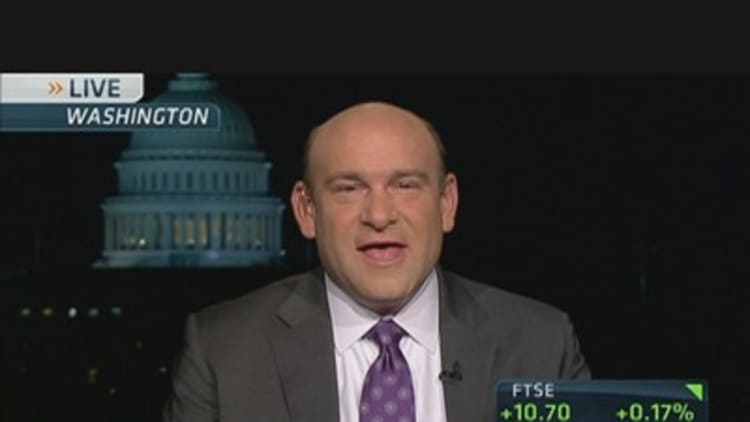The Federal Reserve faces a $4 trillion question, and the stock market's seemingly unstoppable rally could hang on the answer.
With increasing fervor, investors are asking what is the U.S. central bank's exit strategy for getting rid of all the government debt it has bought in an effort to stimulate risk assets and boost the economy.
Will the Fed simply take its chances with inflation and allow all the debt to mature in its own sweet time, or will it begin selling into the marketplace, risking losses that would halt the support payments it is sending to the nation's beleaguered Treasury?
(Read More: CNBC Explains the Federal Reserve)
"At some point they have to exit," said Garth Friesen, co-chief investment officer at hedge fund III Associates and a member of the New York Fed's Investor Advisory Committee. "Until that point they don't want to have premature tightening. How they balance those factors is what they're talking about today, yesterday and what they're going to be talking about in the next couple of meetings."

The Fed's Open Market Committee concludes its two-day meeting today but is unlikely to provide more clues about how it will end its bond-buying program, known in market jargon as quantitative easing.
While it has been more transparent on when it will consider raising interest rates - with targets of 6.5 percent unemployment and 2.5 percent inflation - the Fed has been more circumspect regarding its bond buying.
"I don't think there is one answer," Friesen said. "At the end of the day it comes down to their communication strategy."
The Fed's reticence to divulge their plan for exiting has some of its own members on edge, as a messy exit could throttle a market rally, the ups and downs of which have been closely tied to the asset purchase cycle.
(Read More: Want the Fed to Tighten? Don't Hold Your Breath)
"The minutes from the last two FOMC meetings and several recent Fed speeches suggest that concerns about the costs of QE have risen and that these concerns may impact the conduct of monetary policy in the year ahead," Deutsche Bank economists wrote in a recent report on the Fed's options.
Essentially the Fed has three choices: Either start tapering its purchases, hold the debt to duration instead of selling it, or pick and choose what it sells in hopes of timing the market correctly.
According to a broad swath of market experts who responded to a CNBC survey, the most likely scenario is that the Fed holds onto its assets and doesn't sell them before maturity.
The Fed has created more than $3.2 trillion to buy $1.77 trillion in Treasurys, $1.02 trillion in mortgage-backed securities and a handful of other debt instruments. In addition, it is buying $85 billion a month in Treasurys and MBS, which would bring the total balance sheet to about $4 trillion by the end of 2013.
A plurality of 53 percent predicted in the CNBC poll that the Fed will not sell any of its assets, while 41 percent said the Fed probably would sell both mortgage-backed securities and Treasurys. The rest were split between the Fed selling one or the other, while 14 percent said they were insure what it would do.
(Read More: Wall Street Betting Fed Keeps QE Coming)
Those results closely mirror the most recent Bank of America Fund Manager Survey, where the most popular response was that the Fed would not be selling its MBS portfolio.
Such a strategy comes with risk, though, and the market has counted on the Fed and Chairman Ben Bernanke to chart its course wisely.
"QE has brought peace to the financial world," said Michael Hartnett, chief investment strategist at BofA Merrill Lynch. "Investors say liquidity conditions are the best ever. Few see the peace ending."
Some economists, though, worry that the Fed will take losses on the debt and, at least for a period of time, have to halt the payments it sends to the Treasury on proceeds it gets in normal times from its holdings.
While the amount of those remittances used to be small, it has ballooned - along with the Fed's balance sheet - now to about $90 billion in 2012.
"Assuming the recent firmness of payroll employment growth persists, we expect the Fed to downshift and eventually end its asset purchases during (the second half of 2013). We expect a sharp backup in Treasury yields as these events unfold," Deutsche Bank said in its analysis.
Rising yields would be felt throughout the markets and corporate earnings in particular, which have been helped by cheap capital that companies have used to support their businesses.
Those profits in turn have encouraged investors, who have been chased into the stock market as yields have evaporated on other debt instruments, even high-yielding junk bonds.
(Read More: Fed Throws Junk Bond Lifeline to Weak Companies)
Taken together, the Fed faces some difficult choices about how it will end its easing program without causing market havoc.
"Rising interest rates will send service payments on corporate, private and government debt skyrocketing and that will severely hamper economic growth," Michael Pento, an economist and founder of Pento Portfolio Strategies, said in a note. "The economic fallout from the end of artificial stimuli cannot (in the short term) be supportive of the level of corporate profits."
Pento said the Fed is creating "a bubble that is only becoming more dangerous with each day of the Fed's money printing."
—By CNBC's Jeff Cox. Follow him on Twitter @JeffCoxCNBCcom.


